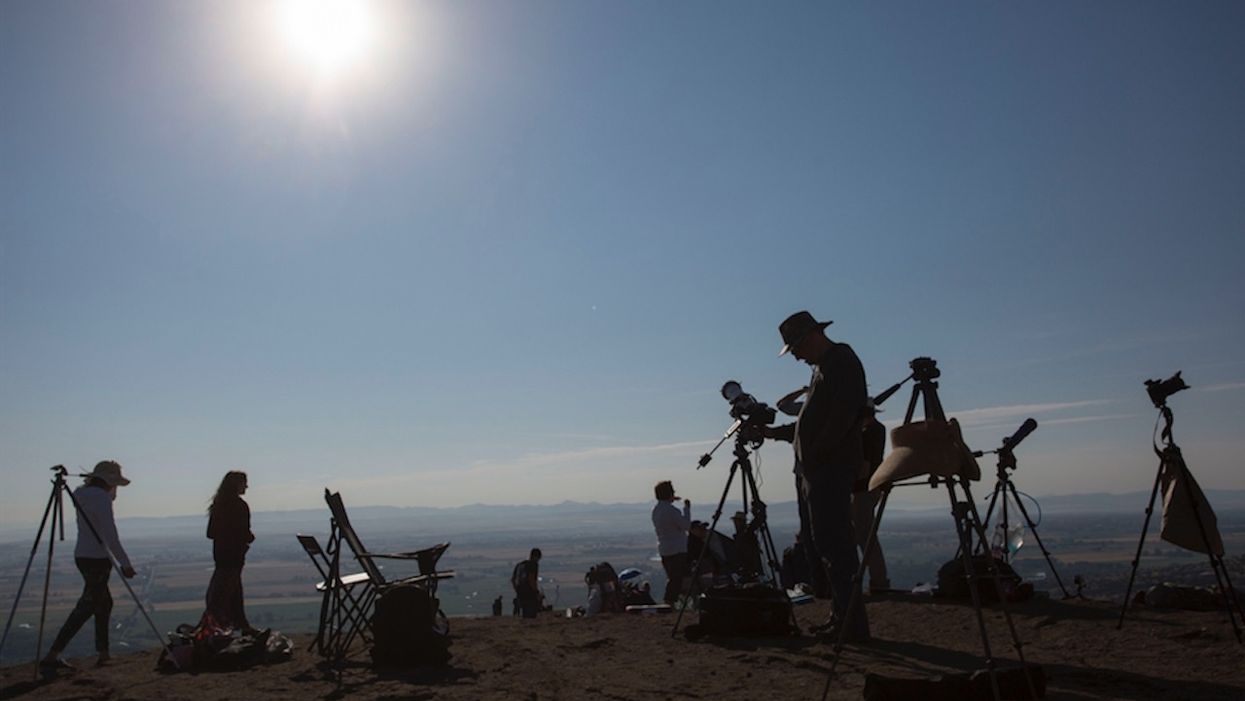
(Photo by Natalie Behring/Getty Images)

"This is as much an experiment in changing social norms and crossing a line as it is a science experiment"
Harvard scientists are gearing up for a solar geoengineering experiment they hope will lead to lowering Earth's temperatures, Nature reported.
The idea is to spray particles into the stratosphere — the atmospheric layer about six to 30 miles above Earth's surface — which would then cool the planet by reflecting some of the sun's rays back into space, the journal said.
The Stratospheric Controlled Perturbation Experiment has its roots in a natural event that occurred almost three decades ago. When Mount Pinatubo erupted in the Philippines in 1991, it injected an estimated 20 million metric tons of sulfur dioxide into the stratosphere, which cooled Earth by around 0.5 degrees Celsius. Nature said the planet's average temperature returned to pre-steam engine levels for about 18 months as a result of the eruption.
The experiment's first phase — a $3 million test involving two flights of a steerable balloon 12 miles above the southwest United States that would release small plumes of calcium carbonate — could launch as early as the first half of 2019, the journal said. Each plume would consist of around 100 grams of calcium carbonate, about equal to what's in an average bottle of antacid, Nature said, and then the balloon would turn around to observe how the particles disperse.
The journal noted that one of the concerns about the experiment is that dimming sunlight could backfire, or at least strongly disadvantage some areas of the world by robbing crops of sunlight and shifting rain patterns.
More from Nature:
But as emissions continue to rise and climate projections remain dire, conversations about geoengineering research are starting to gain more traction among scientists, policymakers and some environmentalists. That's because many researchers have come to the alarming conclusion that the only way to prevent the severe impacts of global warming will be either to suck massive amounts of carbon dioxide out of the atmosphere or to cool the planet artificially. Or, perhaps more likely, both.
Jim Thomas, co-executive director of the ETC Group, an environmental advocacy organization that opposes geoengineering, said of the venture that "this is as much an experiment in changing social norms and crossing a line as it is a science experiment," the journal reported.
Small particles injected into the stratosphere can "spread around the globe and stay aloft for two years or more," Nature said. "If placed strategically and regularly in both hemispheres, they could create a relatively uniform blanket that would shield the entire planet ..."
The journal added that a fleet of high-flying aircraft could deposit enough sulfur to offset roughly 1.5 °C of warming for around $1 billion to $10 billion per year, citing a report last month from the Intergovernmental Panel on Climate Change.
Most solar geoengineering research to date has focused on sulfur dioxide, which is what the Mount Pinatubo eruption released, Nature said — but the sulfur also sped up chlorofluorocarbons' ozone layer depletion, which obviously wasn't a positive. The Sun also warms sulfate aerosols enough to potentially affect the movement of moisture and even alter the jet stream, the journal added.
Therefore the initial stratospheric experiments will focus on calcium carbonate, which is expected to absorb less heat than sulfates and have less impact on ozone, Nature said. But questions remain.
"We actually don't know what it would do, because it doesn't exist in the stratosphere," Frank Keutsch, an atmospheric chemist at Harvard and SCoPEx's principal investigator, told the journal. "That sets up a red flag."
More from Nature:
SCoPEx faces technical challenges, too. It must spray particles of the right size: the team calculates that those with a diameter of about 0.5 micrometres should disperse and reflect sunlight well. The balloon must also be able to reverse its course in the thin air so that it can pass through its own wake. Assuming the team is able to find the calcium carbonate plume — and there is no guarantee that they can — SCoPEx needs instruments that can analyse the particles and, it is hoped, carry samples back to Earth.
"It's going to be a hard experiment, and it may not work," David Fahey, an atmospheric scientist at the National Oceanic and Atmospheric Administration in Boulder, Colorado, told the journal. But his team gave SCoPEx a lightweight instrument that can reliably measure the size and number of particles that are released, Nature added, and the balloon also will have a laser device that can monitor the plume from afar.
Still, he told the journal, moving forward with the experiment and figuring out next steps is crucial: "Not talking about geoengineering is the greatest mistake we can make right now."
Popular Mechanics wrote of the experiment that "chances are, that even with more accurate data the simulations will tell scientists what many of them already suspect: altering the earth's climate is risky and carries a lot of side effects. More research and better simulations might let us find less dangerous ways to dim the sun, but any such experiment will always have a chance of making things worse."